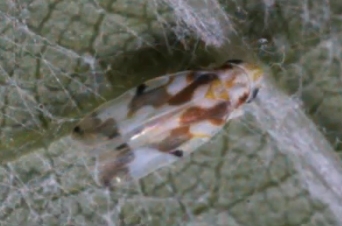UC Blogs
Companion Planting at it's Best
Along with gardening, I have an interest in American history, and combining the two can lead me to hours and hours of exploring and research. I grew up in Santa Rosa and visited Luther Burbank's garden many times. I've been privileged to meet people who knew him and relish in their personal stories and memories. Mr. Burbank's imprint in the botany world has much effect on our current day planting and output.
A fascinating piece of American gardening/history is the legend and practical application of The Three Sisters. Variations of this legend can be found in the ethos of many American Indian tribes, but is primarily attributed to the Iroquois. It is a wonderful example of companion planting and has proven to be one of the most effective techniques ever developed in gardening and farming. This method was was used by Native Americans then later taught to the early European settlers and is still used by many farmers and home growers today.
One version of the legend goes like this:
A long time ago, three sisters lived together in a field. These sisters were quite different from on another in their height and in the way they carried themselves. The little sisters was so young and round that she could only crawl at first and she was dressed in green. The second sister wore a bright sunshine yellow dress, and she would spend many an hour reading by herself, sitting in the sun with the soft wind blowing against her face. The eldest sister, standing always very straight and tall above the other, looking for danger and warning her siblings. She wore a pale green shawl and had dirty yellow hair. There was one way the sisters were all alike, though. They loved each other dearly, and they always stayed together. This made them very strong.
One day a strange bird came to the field; a crow. He talked to the horses and other animals, and this caught the attention of the sisters. Late that summer, the youngest and smallest sister disappeared. Her sisters were sad. Again the crow came to the field to gather reeds at the water's edge. The sisters who were left watched his trail as he was leaving, and that night the second sister, the one in the yellow dress, disappeared. Now the eldest sister was the only one left. She continued to stand tall. When the crow saw how she missed her sisters, he brought them all back together and they became stronger together again. The elder sister stands tall looking out for the crow to this very day. (Shelia Wilson, member of the Sappony Tribe)
The practicalities go like this:
The first sister is corn. She grows tall and provides a pole for the beans which shore up the corn stalks and leave behind nitrogen for the soil. The third sister, squash, shades the bed from weeds and helps the soil retain moisture. Some seed catalogs actually sell packets of three seeds together along with specific directions on how to plant. The method used by Native Americans for hundreds and hundreds of years is still the recommended method.
On June 3, 2011, Cherokee White Eagle corn, Rattlesnake pole beans, and Seminole squash seeds, all donated by the National Museum of the American Indian, were planted at the White House Kitchen Garden by a group of American Indian and Alaska Native youth. According to the First Lady, Michelle Obama, "It turned out to be one of our most successful plantings in the garden."
Garden Confusion
My poor garden is so confused! It is November, correct? I was outside, in shorts and sandals, watering my thirsty plants in the heat this week. So many of the trees have not turned color and started to drop leaves yet. I'm usually doing some pretty heavy raking of leaves by now. I'm wondering if and when fall will arrive here in California.
In spite of the unusual weather, I did do some random fall chores outside. I went ahead and took out the tomato plants, picked the pumpkins and discarded the vines in anticipation of the possible upcoming frost next weekend. The morning glories have continued to bloom every day, although not as profusely. Even so, I pulled down the vines and tossed them in the compost bin. Various perennials were in need of deadheading, so I took care of that. What leaves are falling were raked up, as I don't want to encourage the various fungus and bugs that love their habitat to take over (I have enough trouble keeping rust and black spot at bay as it is on my roses!). I mowed the grass, hoping that if we do have a frost, it'll be the last time I have to mow until springtime.
Turning to my patio, the outdoor furniture is now all under cover from the rains. The summer annuals in the pots were still looking pretty, but I'm ready for winter annuals. So…I pulled out the salvia, petunias, and begonias, cleaned the pots, added fresh soil, and put in some beautiful pansies and cyclamen. With the freshly picked pumpkins next to the pots, it looks much more like fall on the patio.
I hope fall arrives soon!
All Cracked Up!
For the past several years, I’ve had problems successfully growing tomatoes bigger than cherry tomatoes. This year was no exception. Whether it was the cool weather or the increasing shade in my maturing yard, my tomatoes would grow and maybe set fruit but the fruit simply wouldn’t ripen. But finally, in September, one variety—Mr. Stripey—showed some promise by turning color. The few I tasted were delicious. Success at last! But then I noticed that each tomato, without fail, had concentric cracks around each stem. Well, this was a disappointing turn of events that I hadn’t seen before.
After a little research, I learned that these cracks, also known as “growth cracks,” are associated with the tomato’s growing conditions. Concentric cracks circle the top of the tomato around the stem while radial cracks extend in a straight line down the side of the tomato from the stem. Both types of cracks are caused when a plant receives too much water after a dry spell, either through excessive watering or after a rainy period. In essence, the plant receives too much water too fast, causing the interior of the tomato to expand too fast for its skin to stretch enough. The skin then cracks to relieve the pressure.
My plants are watered regularly by timed drip irrigation, so I was a little surprised to learn that this system could result in excessive watering (if anything, I’ve been fairly sure that they get under-watered.) But then I learned that some beefsteak-type varieties, like my Mr. Stripey, are prone to cracking. Perhaps that explains it!
Cracked tomatoes are still edible, but are prone to rot or disease setting in quickly. The cracked portion can simply be cut away. In my case, once the cracking appeared, I never was able to beat the rot before picking the tomato.
What can I do to avoid this problem next year? First, try a crack-resistant variety with more elastic skin (e.g., Early Girl, Jet star, Mountain Spring or Mountain Fresh). Second, mulch plants once they are established to help retain soil moisture. Third, pay closer attention to my plants’ irrigation needs, particularly after a hot spell. Although, given my luck with tomatoes lately, I may rethink my summer vegetable garden entirely!
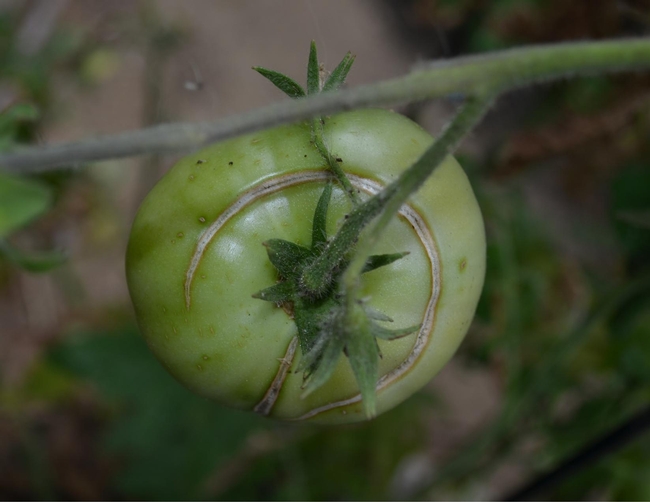
Cracked green tomato, 'Mr. Stripey'. (photos by Erin Mahaney)
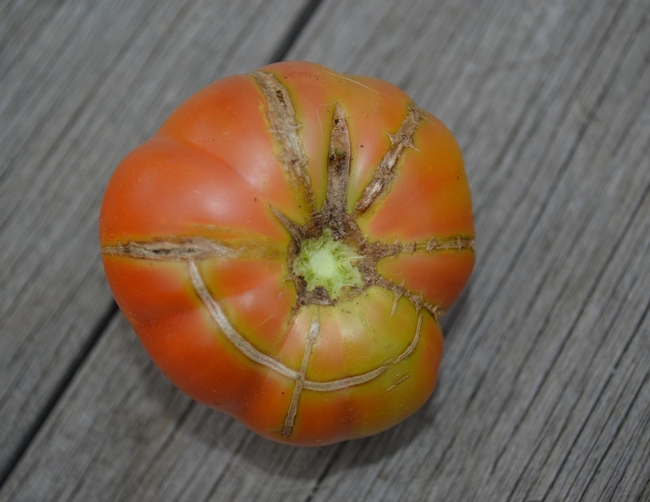
Cracked red 'Mr. Stripey'.
New pest found in California vineyards
The Virginia creeper leafhopper has been found in vineyards from the Oregon border to the northern Sacramento Valley, but so far has not made its way to the storied vineyards of Napa or Sonoma counties, according to an article in The Grower.
Reporter Vicky Boyd based the article on a report by Lucia Varela, UC Cooperative Extension advisor, an integrated pest management expert for the north coast of California. So far, the Virginia creeper leafhopper has been reported primarily in backyard and organic vineyards.
Western leafhoppers are common in California vineyards. Many are controlled by natural enemies. Whether the same will hold true for the Virginia creeper leafhoppers is unknown.
Learn how to distinguish the two leafhoppers by watching the 4-minute UCCE video below.
Fifth annual sheepdog trials in Hopland showcase dogs' skills
Tiffany Revelle, Ukiah Daily Journal
Dog handlers competed recently in the 5th Annual Sheepdog Trials, held on the rolling hills of the UC Hopland Research and Extension Center.
Sheepdog trials are held all over the nation, allowing dogs to accumulate points that count toward a national competition where the top 150 compete for the top spot, bragging rights, and possibly, for money-making opportunities that could include training or breeding, according to Bob Keiffer, superintendent at Hopland.
Just Waiting in the Germander
It's no secret that bees are fond of germanders or Teucrium, a genus in the mint family, Lamiaceae. And it's no secret that praying mantids are fond...
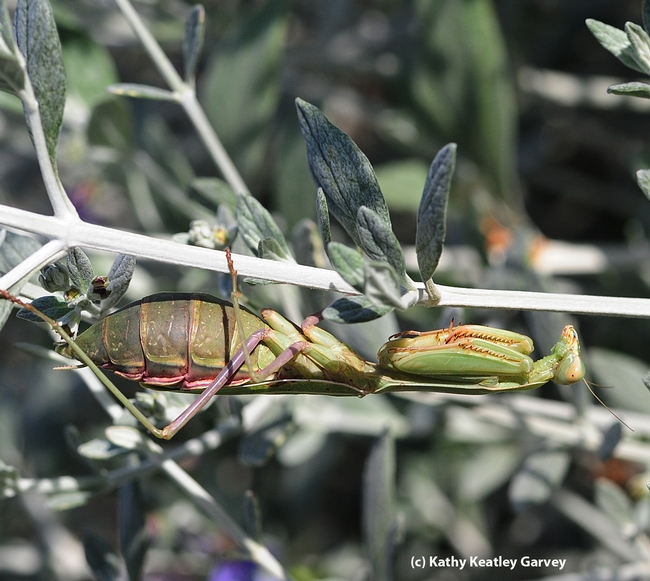
Pregnant praying mantis camouflaged on a germander twig. (Photo by Kathy Keatley Garvey)
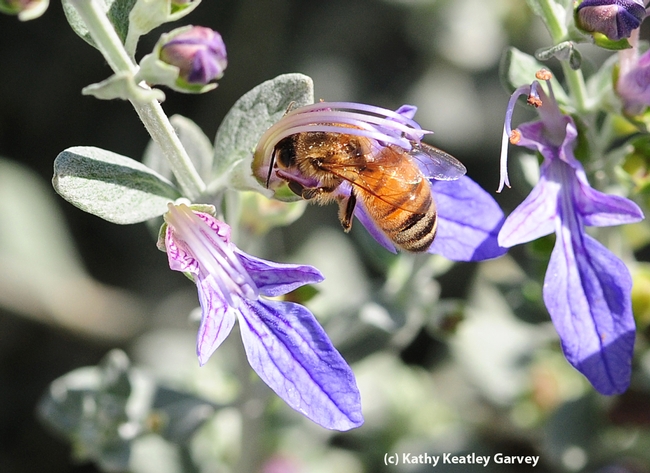
Honey bee nectaring on germander. (Photo by Kathy Keatley Garvey)


